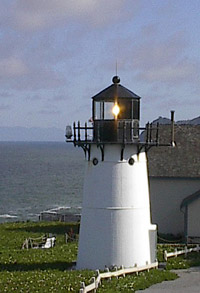| 
 Lighthouses
are most well known for alerting sailors to hazards and coastlines
during the night, or through conditions which impeed visibilty,
such as rain and fog. However, lighthouses also help to mark
the coast by day. Lighthouses
are most well known for alerting sailors to hazards and coastlines
during the night, or through conditions which impeed visibilty,
such as rain and fog. However, lighthouses also help to mark
the coast by day.
A
system developed by the Lighthouse Board (est. 1852 by U.S.
Congress) designated individual lighthouses as "daymarks"
by the use of painted patterns. Unique patterns painted on
lighthouses enable sailors to recognize them as markers for
particular locations during the day. Although many lighthouses
are painted with similiar patterns, they are far enough apart
to prevent them from being confused with one another.
Some
lighthouses have simple bands of color, others are painted
with spiraling lines and still others are painted one solid
color. The most common colors used to paint lighthouses are
white, black and red.
A
few lighthouses notable for their markings include:
- Bodie
Island Light (Nags Head,
NC)
- three
white and two black horizontal bands
- Cape
Bonavista Light (Bonavista,
Newfoundland, Canada)
- white
with vertical red stripes from top to bottom
- Cape
Hatteras Light (Outer Banks,
NC)
- a
black spiral against a white background
- Cape
Henry Light (Chesapeake Bay,
VA)
- long,
vertical black and white checkerboard pattern
- Cape
Lookout Light (Cape Lookout
National Seashore, NC)
- large
black and white diamond pattern
- West
Quoddy Head Light (Lubec,
ME)
- eight
thin, horizontal red stripes against a white background
|

